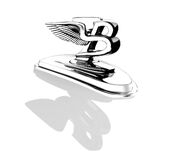
| |
| Bentley Speed Six | |
|---|---|
| Bentley | |
| aka | Bentley 6½ L |
| Production | 1926–1930 545 produced |
| Class | {{{Class}}} |
| Body Style | {{{Body-Style}}} |
| Length | {{{length - type here}}} |
| Width | {{{Width - type here}}} |
| Height | {{{Height - type here}}} |
| Wheelbase | 132 in (3353 mm) 138 in (3505 mm) 140½ in (3569 mm) 144 in (3658 mm) 145½ in (3696 mm) 150 in (3810 mm) 151½ in (3848 mm) 152½ in (3873 mm) |
| Weight | {{{Weight - you get the point}}} |
| Transmission | {{{transmission + drive}}} |
| Engine | {{{engine}}} |
| Power | {{{Horsepower and Torque rating}}} |
| Similar | {{{similar (competition)}}} |
| Designer | {{{Designer (lead designer if it was a team effort)}}} |
Desiring more power, Walter Owen Bentley added two cylinders to the straight-4 engine used in his 4½ Litre car, creating the 6½ Litre Bentley in 1926. A high-performance Speed Six model was famed for its racing success.
Engineering[]
The 6 L car was inspired by the Rolls-Royce Phantom I as a closed-body car. Although based on the 3 L, it incorporated many improvements. The cone-type clutch was replaced by a dry-plate design, incorporating a clutch brake for fast gear changes, and four wheel finned-drum brakes were used. The front brake drums had 4 leading shoes in each drum and the brakes were also power assisted - another first at the time. A single adjustment took care of the wear of all four brakes (an ingenious patented compensating device made this possible) which was adjustable by the driver, whilst in motion, from the driving seat. This was particularly advantageous during racing. Like the four cylinder engine, Bentley's straight-6 included overhead camshaft, 4 valves per cylinder and two sparking plugs per cylinder, all exotic technologies at the time, as well as a single-piece engine block and head cast in iron, and therefore no head gasket to blow. Bore and stroke dimensions were identical to the 4½ L car at 100 mm (3.9 in) and 140 mm (5.5 in), respectively, giving a total of 6.6 L (6597 cc/402 in³) of displacement.
180–200 hp (134–149 kW) was produced, and the car was faster and more reliable than the supercharged Bentley Blower produced at the same time.
A large variety of wheelbases were produced for such a low-production car, ranging from 132 in (3353 mm) to 152½ in (3873 mm).
Speed Six[]
The Speed Six was introduced in 1928 as a more sporting version. It would become the most-successful racing Bentley, claiming victory at the 24 Hours of Le Mans in 1929 and 1930 with drivers Woolf Barnato, "Tim" Birkin, and Glen Kidston.
However, the Speed Six was fitted as a conventional road-car, and many were used apart from racing. Two saloon-bodied Speed Sixes even served as patrol cars for the Criminal Investigation Department of the Western Australia Police Force.
Production[]
- 6½ L: 363
- Speed Six: 182
Gallery[]








